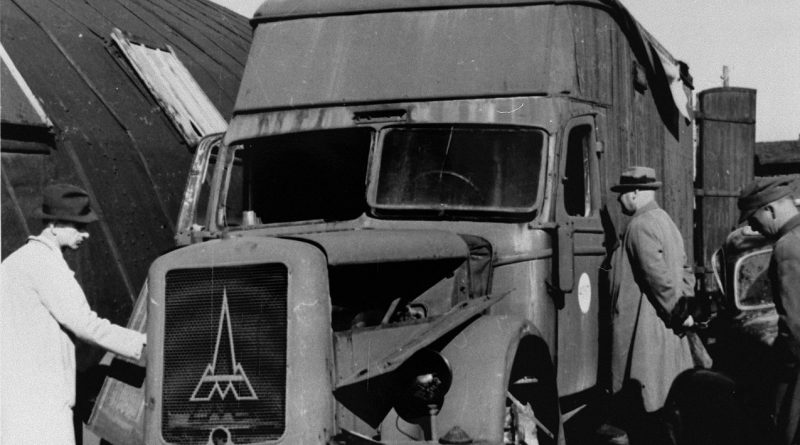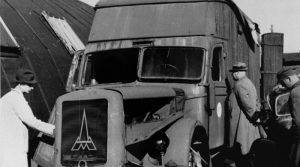The Gas Vans: A Critical Investigation

By Santiago Alvarez
When it comes to the “Holocaust,” the alleged mass murder of European jews by the Third Reich, most people think they “know.” Of course we all “know” that it happened. We “know” that six million died. We “know” that the “Nazis” pushed the jews into the gas chambers and gas ovens, that they burned them, dead or alive, in gigantic crematories and on huge pyres. Our knowledge is so certain that anyone uttering disbelief is swiftly ostracized. In many countries people even call the police and have doubters arrested, prosecuted, and sent to prison. He who doubts what everybody knows to be true must be evil, indeed.
Most readers perusing the above sentences might not even notice that it contains a typical error, a falsehood even acknowledged by orthodox historians. This error has to such a degree become a fixed part of the cliché which we consider to be “knowledge” that it passes unnoticed.
There were no gas ovens.
The term makes no sense.
Mainstream historians claim that there were gas chambers on the one hand, designed to quickly asphyxiate hundreds, if not thousands of people at a time within mere minutes. On the other hand everybody agrees that there were crematory ovens, designed to reduce deceased camp inmates to ashes (although the inmates’ cause of death and the crematories’ capacities are disputed). In the mind of the public at large, though, gas chambers and crematory ovens have merged to some ominously sounding “gas ovens.” The public discourse about the Holocaust is replete with that nonsensical term, even though what it describes never existed.
So much about “we know.”
Listing and explaining all the false clichés prevailing in the public about the “Holocaust” would fill a separate book, so I will abstain from doing it here. The point I was trying to make is that, although we all have some basic grasp about what is meant by “the Holocaust,” most people are quite unfamiliar with even general aspects of the topic.
While gas chambers dominate the public’s mind when the specter of the “Holocaust” is raised, “gas vans” are usually absent from the discourse. What percentage of the general populace has ever heard that the “Nazis” are said to have deployed mobile gas chambers as well, which historians usually call “gas vans”?
This lack of knowledge is excusable, because even in orthodox historiography the “gas vans” have played only a minor role. To this date no monograph has appeared on the topic written by a mainstream historian. Mere articles published in journals or anthologies exist, and most of them do not even focus on the gas vans themselves but instead on some location like the Chełmno camp in Poland or the Semlin camp in Serbia, on certain German armed units, in particular the German antipartisan Einsatzgruppen behind the Russian front, or events where they are said to have been used, like the euthanasia action, to name a few. We will encounter many of these papers in the present study. But before doing this, I want to discuss the one mainstream paper which comes closest to a study of the gas vans as such. By so doing we will recognize the dire need for a much more thorough and critical study.
In 1987 German historian Mathias Beer published a paper whose German title translates to “The development of the gas vans for the murder of the jews.” In it he tries to describe, based on 14 documents and many more testimonies, how National Socialist Germany developed this murder weapon. Right at the beginning of his paper he admits that all extant documents are from a late phase of these vans’ deployment, hence could elucidate little about their development. To remedy this, he resorts to verbal claims made by various persons asserting to have witnessed something, most of whom were interrogated during some criminal investigation or trial. Knowing that by relying on such statements Beer enters shaky territory, he declares that “due to their peculiarities testimonies” need to always be linked to, that is to say supported by, some documents, and that those documents themselves need to be “subject to thorough source criticism” (all on p. 404).
I agree with this, as this is a standard method of historiography. Yet Beer has missed two important issues here: first of all, each testimony, whether supported by a document or not, needs to be subjected to criticism as well. Next, Beer completely omits the most important group of evidence: physical, tangible evidence.
Beer is completely mute on all accounts: no scrutiny of the witness testimony performed, no material traces requested, no questions asked about the construction and operational mode of these vehicles. And worse still: he fails his own criterion that document criticism is pivotal, because his paper does not contain any critical discussion of any of the documents he cites or at least a reference to such a discussion (which does not exist among orthodox historians, I may add).
Hence Beer’s paper is a complete failure already on formal grounds. But that is not the end. His self-defined goal to trace the development of the gas vans within the framework of documents falls flat as well. As Mattogno has shown (2011a, chapter 1), Beer’s lengthy “reconstruction” of how the gas vans allegedly came into being is not based on any documents, as Beer himself admitted. What remains are the testimonies on which Beer relies heavily. We will encounter most of them in this study, where we will subject their statements to critical scrutiny. The result is shocking: many of the important witness statements used by Beer can be demonstrated to be highly implausible (see, for instance, two of the persons allegedly responsible for the vans’ development: August Becker, chapter 3.7.3.3., and Albert Widmann, chapter 3.7.4.7).
Any decent researcher would have taken such critical inquiry as a reason to look into his own research again and to amend it where necessary. But such an open-minded approach does not seem to be Beer’s cup of tea, for when he had a slightly abridged and updated version of his 1987 paper published in a 2011 anthology (Morsch/Perz/Ley, pp. 154-165), it exhibited the same deficiencies of superficiality. Here again, Beer’s references to documents and witness accounts serve only to once more uncritically repeat what he has read. In addition, this new version of Beer’s paper also lacks any reference to – and discussion of – any topical criticism made during the past two decades (mainly Marais 1994 and Weckert 2003). Hence Beer, like most mainstream Holocaust authors, has proved to be impervious to critique, which means that he is insusceptible to the scientific method.
In view of the total failure of orthodox historiography to appropriately address the issue of the “gas vans,” Pierre Marais 1994 monograph on the “gas vans” was a sorely needed study indeed. Unfortunately it remained without any reaction from the historiographic establishment. The present study will start by including and summarizing what Marais has already revealed and by carrying the topic farther and deeper.
In the case investigated here the allegation is made that during the Second World War a huge number of individuals was killed at various points in time and at numerous locations by means of “gas vans” deployed by German units. Some of the killings are said to have happened in the course of fighting partisans in the Soviet territories temporarily occupied by the Germans; others ostensibly happened in the context of the implementation of the so-called “Final Solution to the jewish question,” which, according to orthodox historiography, meant the physical annihilation of many jews within the German realm of influence during World War Two.
The partisan warfare during World War Two followed its own, at times cruel, rules. In this context, summarily killing partisans was not an illegal activity, if judged by international law as in effect at that time. Even West German courts of law dealing with partisan killings allegedly committed with “gas vans” did not sentence any defendant on this ground alone, as killing partisans by whatever means, as long as it was not excessively cruel, was considered a legal act of war. Communist East German trials, on the other hands, always considered the killing of partisans a crime (see chapter 3.8.1.). Since the present study is not about legal considerations but rather about the evaluation of evidence presented, the legal aspects will not be discussed any further.
Although most of the killings said to have been perpetrated with “gas vans” are claimed to have occurred within the so-called “Final Solution,” I will not enter into a discussion of this term and its historical interpretation either, as this would lead us far astray from our actual topic and because both orthodox and revisionist literature about the “Final Solution” are replete with considerations on this topic.
In these “gas vans” the Germans are said to have used the vehicles’ exhaust gases for homicides, the most toxic component of which is carbon monoxide (CO, sometimes also referred to as carbon oxide). This gas is a result of an incomplete combustion of the carbon component of fuels consisting of hydrocarbons, like gasoline and Diesel fuel. Complete combustion leads to carbon dioxide (CO2), which is much less toxic than CO. I will elaborate on this a little more in chapter 1.3. Suffice it here to say that the claimed weapon of crime in a more narrow sense is said to have been a standard truck or van engine as it was mounted into the vehicle by the manufacturer without any modification. The truck itself, however, is said to have been retrofitted with certain additional equipment permitting the actual homicide. What exactly these changes to the serial trucks and vans were is one of the central questions to be elucidated by the present study, next to determining the make and model of the trucks themselves as well as the engines used.
German documents from 1942 prove the order of thirty special cargo boxes mounted onto the chassis of Austrian Saurer trucks sporting Diesel engines. 6 The vehicles thusly equipped are claimed to have been used as “gas vans” especially by the so-called Einsatzgruppen, German armed forces officially in charge of combating partisans operating behind the German lines at the eastern front. One would therefore have to expect that one or several of these vehicles were captured by the Soviets during their counter-offensives, but this is apparently not the case.
In fact, no information exists about a location where one could investigate a wreck of such a gas van or even only some instructive traces of the special retrofitting which inevitably would have been required for the deployment of these vehicles for homicidal purposes. The Soviets, however, are said to have captured some of those responsible for the homicides in gas vans, whom they put on trial in 1943 (see chapters 3.2. and 3.3.). How do they explain the fact that they managed to catch some of those who had operated the trucks, but that the vehicles themselves simply vanished?
Mainstream historians, like Mathias Beer, are wont to respond to this glaring lack of any material trace of these elusive vans by coming up with a pseudo-explanation (see Beer’s letter to P. Marais, p. 365):
“It would not be surprising if no gas vans had been found after the war, because the gas vans, like all other traces left by the extermination of people, were destroyed as best as possible in the rush.”
This does, however, render Beer’s position even worse, as this claim also requires supportive evidence – this time to prove that the “Nazis” did indeed manage to erase all those traces, and how this was possible. After all, the lack of evidence does not prove a claim to be true, which is what Beer tries to argue here. If anything, the lack of evidence refutes the claim.
As we will see, the operation of a truck suffocating humans locked inside of it is rather easy. There are no difficulties constructing it, and its production a posteriori would doubtlessly have been quite easy. That no such attempt was ever made makes the whole issue even more mysterious.
The claim that thirty vehicles retrofitted for mass gassings, which would have served as a vivid example of the “Nazi barbarity,” have simply disappeared without trace ineluctably had to raise certain doubts about their very existence. Unless new information surfaces, one cannot but conclude that the “murder weapon” in the form of these infamous “gas vans” could not be produced to this very day. There are absolutely no tangible material items: no truck, no part of a truck, no drawing or blueprint of a truck. As we will see during the analysis of the existing documents, not even a technical study of these ostensible gassing vehicles exists, and it is incomprehensible how such a vehicle could have been constructed without a corresponding technical drawing.
If, due to lack of reliable information, one assumes that not a single gas van and no characteristic part of it survived the war, then the next question to ask is whether photographs of the time span exist during which these vehicles were allegedly used. And in fact, several photos of vehicles do indeed exist about which it is claimed that they served as “gas vans.”
The originals of these photos (four of them all in all) were taken by the Commission of Inquiry into the German crimes in Poland at war’s end and are now in the Commission’s archives in Warsaw (signatures 47396 to 47399). Copies of the originals of these photos are, i.a., located in the archives of the Auschwitz State Museum and of the Yad Vashem Institute in Jerusalem, from where one can easily procure a copy.
Although both Gerald Fleming and Christopher Browning have claimed that this is a homicidal “gas van”, an impartial observer can easily recognize that nothing visible about this vehicle supports this claim. But then why do orthodox historians like Browning and Fleming present it as a depiction of a gas van for homicide? Have they investigated and verified their sources before they added their caption to this photo of an absolutely mundane, apparently decommissioned vehicle – perhaps one among many thousand others that could be found?
Another detail catches the attentive reader’s eye: All witnesses quoted in the literature as well as in the various court protocols claim that the “gas vans” exclusively belonged to the five makes Saurer, Diamond, Opel, Renault, and Daimler Benz (see chapter 4.2.2.); Magirus is not mentioned a single time. The two important documents which we will discuss later in detail likewise mention merely “gas vans” made by Saurer and Diamond.
Today the Chełmno Museum shows one of the photos discussed above in its exhibition with a truthful caption reading: “Vehicle found after the war at Koło on the grounds of the Ostrowski factory.” The connection to the gas vans is not made explicitly, but the mere fact that it is exhibited will inevitably lead the visitor to think that this must have been such a vehicle. This disingenuous trick is typical for museums of that kind.
All things considered, there does not exist any pictorial evidence for the existence of “gas vans.” If photos existed, their owners would most certainly have published them by now. But since this is not the case, the only possible conclusion is that the “murder weapon” can just as little be seen on photographs as in reality, although there is a spate of reports presenting the gas vans as a proven historical reality beyond any doubt.
If the gas vans existed indeed, then we need to find out the conditions under which they were constructed and used. In view of the thoroughness and the Germans’ talent to organize, some documentary traces must have been left behind, unless one accepts the improbable thesis, which is nonetheless systematically invoked by certain historians, according to which this operation had been carefully camouflaged and that all traces have been erased.
Although it is relatively easy to construct a vehicle which asphyxiates its passengers during transit, its manufacture requires certain tasks to be done in a workshop, which are unimaginable to have been performed spontaneously. The decision to build such vehicles inexorably had to come from the top of the hierarchy, and it then had to be handed down from one level to the next lower one down to those responsible for carrying out the necessary experiments and to those charged with deploying the vehicles.
Although I have of course no experiences in this regard – and for good reasons – it seems to me that the construction of vehicles meant to kill persons locked up inside of them during transit had to include under any circumstances three technical adaptations:
a) Since panic among a large number of persons can drive people to extremes, such a cargo box would have to be especially strong. Hence, a robust cargo box structure had to be bolted to the chassis, fitted inside with a cage resembling a zoo’s big cat cage, which could withstand both shocks during the ride as well as escape attempts of those lock up inside. This is especially true for the door, which had to be particularly reinforced in order to keep the panicking victims securely locked up inside, even if they all stormed the door. In this context I may remind the reader that a panicking crowd collectively pressing against doors, fences or even walls can make them collapse. A standard rear door of a normal van would not have done the trick. Needless to say that no such construction can be found in the documents we are about to examine.
b) If exhaust gases were used to suffocate the victims, an engine type had to be used whose exhaust gases produced sufficient carbon monoxide to kill within a few minutes. This is to say: the truck had to be equipped with a gasoline engine. Alternatively and more conducively, a vehicle equipped with a wood gas generator could have been used with a means to alternatively switch the wood gas to flow either to the engine or into the cargo box, although this would have rendered the van immobile during gassing operations.
c) If exhaust gases were used, and if occasionally the truck’s cargo box was also to serve as a normal transport device, then a mechanism is expected to have been added permitting to alternatively pipe the exhaust gases either to the outside as usual or through a hole into the cargo box. A flexible metal hose or a telescopic pipe extension which can be reversibly attached to the exhaust pipe comes to mind.
d) The entry hole inside the cargo box emitting the noxious gases needed to be designed in such a way that the passengers, any accidentally falling objects or any fluid would be unable to destroy or block/plug it.
e) Furthermore there needed to be at least one pressure relief valve or opening for the excess gases to escape. The latter point is very important and in my view is a conditio sine qua non for the functioning of the gas van.
If thirty such vehicles have existed, as is claimed, this means that these design changes would have been made to thirty vehicles. Under these circumstances we would have to expect at least a part of the pertinent documents in the archives, namely: correspondence on the highest level about the feasibility of the operation, a decision to allocate the required financial resources, correspondence with companies in order to obtain technical advice, cost estimates including construction blueprints, orders, invoices, etc.
In order to get an idea about the quantity of documents which would have been required for the construction of vehicles, it suffices to imagine that for instance the locksmith shop at Auschwitz received detailed written instructions even for the most minute maintenance work.
Conclusions
There can be no doubt that the Germans of the later 19th and early 20th century were a special breed. Just imagine all the things they did: they invented the gasoline engine, the Diesel engine, the Wankel engine, the jet engine, and the rocket engine; by the end of WWII they had the first rockets, first jets, first helicopters, first stealth submarines, first plans for building space shuttles and stealth bombers; by that time they had also invented nerve gases, had discovered nuclear energy, developed coal gasification, invented artificial rubber, the video telephone, the amateur video camera, infrared-based night vision devices, tape recording, TV, live TV, color TV, cable TV, microwave ovens, discovered the link between smoking and lung cancer, built the first computer (Zuse, tube-based), and last but not least the electron microscope.
What can one expect from such a people when they turn their energy to murdering people en masse? Crude, hardly operable makeshift solutions?
Because this question is not rhetorical in nature, I hope that the reader will permit me to delve into the matter a little bit deeper. The question is, more accurately put, what options the Germans had and which one they would have chosen to commit mass murder. This might sound a little crazy, as it appears to be a contest in mass murder, but this thought experiment is necessary to realize the nature and quality of the claims made about the gas vans, among other things.
In his study of the alleged Auschwitz gas chambers, Germar Rudolf has discussed the various options available to the Auschwitz camp authorities (Rudolf 2011, pp. 226-229), while Fritz Berg has done something similar for the Aktion Reinhard camps (in Rudolf 2003, pp. 459- 462), and in his study about Chełmno, Carlo Mattogno has marveled over the question why the Germans are said to have used CO, when they had at their disposal numerous other agents which were much more potent (Mattogno 2011a, toward the end of his chapter 2).
I will not argue here that carbon monoxide would not have been a good choice for the Germans – or anyone else intending to kill with a toxic gas. Any other, more potent agent always has the severe drawback that it is also very dangerous for the perpetrator. But not CO, if a few safety rules are observed. In addition, CO can be generated easily and cheaply, is easily applied, and is easy to discard. Once released into the environment, it quickly dilutes down to harmless concentrations and is rapidly oxidized to innocuous CO2.
The question is: how would the Germans, ingenious engineers and chemists as they were back then, have constructed a “gas van”? I do not wish to go into details here, but will focus mainly on the source of carbon monoxide. The attentive reader might already guess what I am getting at: producer gas vehicles. Already after World War One this technique was developed in Germany, and during World War Two the Germans improved that technique to a high standard and produced hundreds of thousands of these devices.
Hence, if the Germans had used the Saurer trucks mentioned in the Gaubschat exchange as gas vans – or any other truck – they would have been equipped with wood gas generators, and this very gas – before(!) entering the engine – would have been used to kill the inmates locked up in the cargo box. I have prepared a drawing of such an operational hypothetical Saurer gas van; see Illustration 27 (p. 379).
Illustration 26 (p. 378), on the other hand, shows a draft of an impossible “gas van” as described in the pertinent literature using the exhaust gases of a Saurer Diesel engine, piped into the cargo box’s floor via a metal hose. The vehicle’s dimensions are based on the Gaubschat correspondence (cargo box height to length ratio 1.7:5.8). The problems with such a design are insurmountable. Such vans could simply not have served the function ascribed to them.
Today, after several decades of extended and exhaustive archival and forensic studies, we know with a probability bordering on certainty that there never were any stationary “gas chambers” for the mass murder of human beings. Is the situation identical with regard to the “gas vans”? Back in 1994 Pierre Marais concluded in his tome that his studies did not yield any evidence for their existence. Although I have been able to scrutinize many more sources than were available to Marais, my own verdict is basically the same:
➢ There are still no material traces of these vehicles and no photos.
➢ The forensic findings about claimed gassing victims presented during communist show trials are not worth the paper they are written on.
➢ None of Marais’s reasons to doubt the authenticity of the key documents alleged to prove the gas vans’ existence have ever been addressed, let alone refuted, and I have found more such reason to suspect foul play.
➢ The few additional documents not known to Marais which I have analyzed here have increased the impression that such documents are either ambiguous (Activity Report by Einsatzgruppe B) or highly suspicious (the Turner letter).
➢ The contradictory and at times absurd nature of witness testimony, already demonstrated by Marais, has been revealed in an even more glaring light in this study.
All this does not prove that gas vans never existed. But then again, having no evidence for the existence of the Flying Spaghetti Monster doesn’t refute its existence either. He who wants to believe will always do so. However, he who wants to have unequivocal evidence will not find it – for now.
Source: http://www.renegadetribune.com/the-gas-vans-a-critical-investigation/










